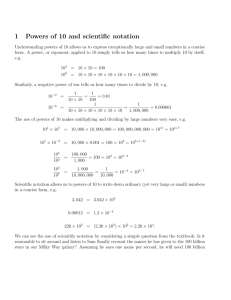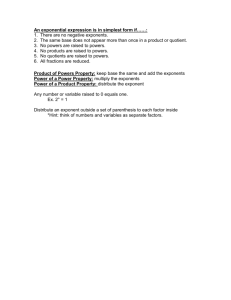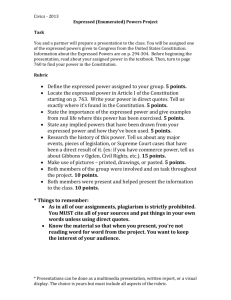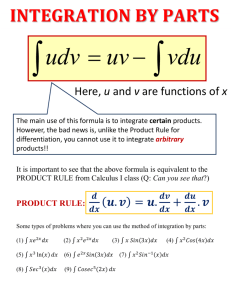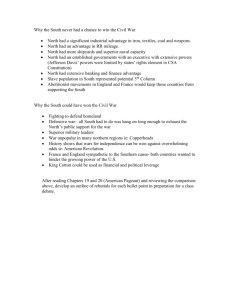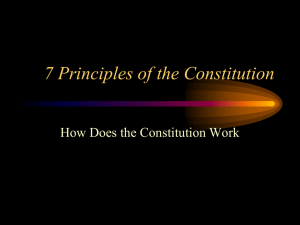Social Studies Lesson Plan- SS.5.C.3.3 Give examples of
advertisement
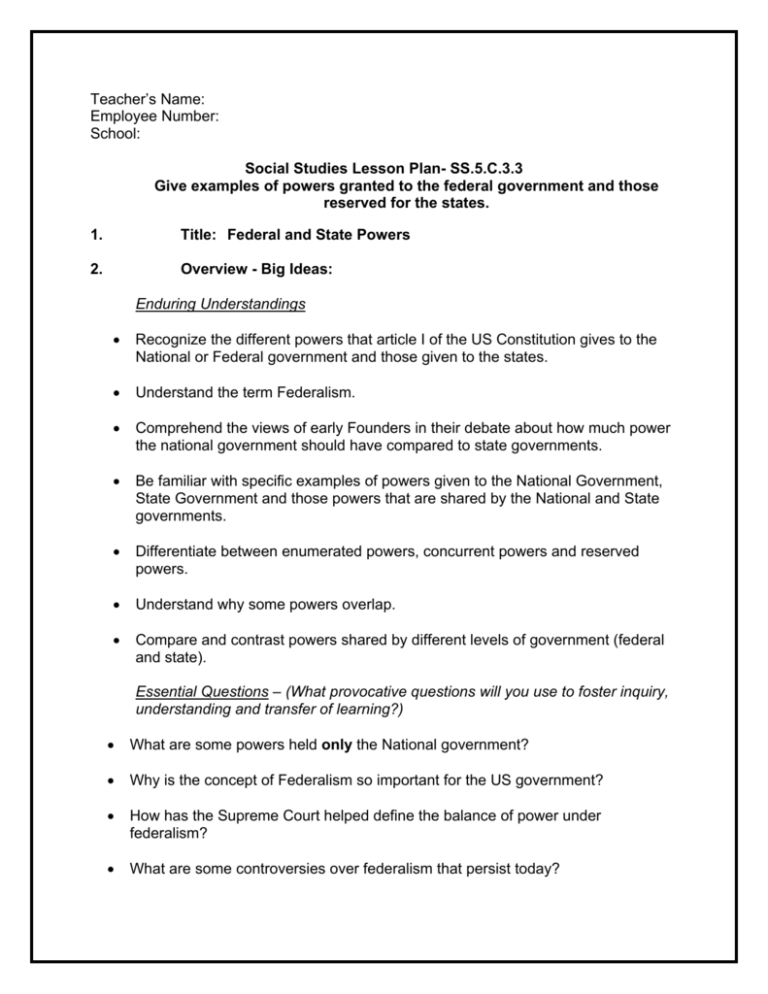
Teacher’s Name: Employee Number: School: Social Studies Lesson Plan- SS.5.C.3.3 Give examples of powers granted to the federal government and those reserved for the states. 1. Title: Federal and State Powers 2. Overview - Big Ideas: Enduring Understandings • Recognize the different powers that article I of the US Constitution gives to the National or Federal government and those given to the states. • Understand the term Federalism. • Comprehend the views of early Founders in their debate about how much power the national government should have compared to state governments. • Be familiar with specific examples of powers given to the National Government, State Government and those powers that are shared by the National and State governments. • Differentiate between enumerated powers, concurrent powers and reserved powers. • Understand why some powers overlap. • Compare and contrast powers shared by different levels of government (federal and state). Essential Questions – (What provocative questions will you use to foster inquiry, understanding and transfer of learning?) • What are some powers held only the National government? • Why is the concept of Federalism so important for the US government? • How has the Supreme Court helped define the balance of power under federalism? • What are some controversies over federalism that persist today? • What are some current issues/events related to how much power the National government should have? • How does federalism limit the government? • What are some examples of enumerated, concurrent and reserved power? 3. Lesson Objectives Standards - Next Generation Sunshine State Standards for Social Studies Fifth Grade NGSSS-SS Benchmarks • SS.5.C.3.3 Give examples of powers granted to the federal government and those reserved for the states. Tested Seventh Grade NGSSS-SS Benchmarks Relevant to this Lesson 4. • SS.7.C.4.1 Differentiate concepts related to United States domestic and foreign policy. • SS.7.C.4.3 Describe examples of how the United States has dealt with international conflicts. Key Vocabulary: Article I, concurrent powers, Constitution, enumerated powers, expressed powers, Federalism, foreign affairs, reserved powers, Supremacy clause, trade, 5. Evidence of Student Understanding (Assessment) in this Lesson: What key knowledge and skills will students acquire as a result of this lesson? After students complete this lesson, they will be able to understand how Federalism limits the power of government. Students will be able to understand that there are specific powers given to the national government and to the states, yet some powers shared by both. They will also be able to analyze the importance of certain Supreme Court rulings as they relate to the concept of federalism. Furthermore, they will be able to compare and contrast the different powers given to the different levels of Government. What will students be able to do as a result of such knowledge and skills? As a result of acquiring the knowledge and skills addressed in this lesson, the students will be able to complete the attached graphic organizer classifying the powers of different levels of government. They also will compare and contrast the different powers. Students will evaluate the balance of national versus state power. Additionally, students will be able to correctly answer the questions that are part of the formal assessment included with this lesson. Both formative and summative assessments are included 6. Materials Needed: Attachment A: Chart: Levels of Government Attachment B: Reading #1: The Federal System Attachment C: Blank map of USA Attachment D: Graphic Organizer: Enumerated powers, Concurrent powers and Reserved powers Attachment E: Post Quiz 7. Steps to Deliver the Lesson: A detailed, step by step description of how to deliver the lesson and achieve the lesson plan objectives. a. Lesson Opening: Briefly review the different levels of government. Explain to students that the United States has three levels of government: National, State and local. Show students the chart listing the different levels of government (attachment A). Distribute the blank Map of the United States (Attachment C) and ask students to label it using the concepts from Attachment A. Students should label the USA as a national government, draw their state and put state government, and finally draw their city/county. b. Reading: Distribute reading (Attachment B): The Federal System. Use jump in reading or other effective reading strategies appropriate for your class to read the background information contained in the article. c. Distribute a piece of red, green and yellow construction paper (about 8” x 4”) to each student. Go to the website listed below: http://www.centeroncongress.org/interactive-learning-modules Click on civic participation, next click on “where to go with a problem.” Read the different problems and ask students to raise the red paper if they think the problem belongs to the National government, the green paper if they think that the problem belongs to the state government and yellow if the problem belongs to the local government. Drag to the appropriate level of government. Repeat activity for each problem given. d. Distribute and discuss the graphic organizer (Attachment D): Enumerated, Concurrent and Reserved powers. Ask students to write examples using the Reading selection (Attachment B). e. After students have finished writing examples for each category ask students to share their answer and write some of them on the board. g. Have students take the post-quiz associated with this lesson (Attachment E). Go over the quiz with students. Check for understanding and re-teach any concepts not understood. 8. Specific Activities: (From Guided to Independent) Activities designed to facilitate the gradual release of teacher responsibility, from teacher-led to independent a. After students have completed the two activities and the graphic organizer (Attachment D) have students write a 1-2 paragraph journal entry explaining why some powers could be shared between the federal and state governments. b. Pair students who are struggling readers and/or English Language Learners with another student for assistance. c. Circulate the room to monitor students’ abilities in writing the journal entry. If students have difficulty with this assignment, model a sample journal entry on the white board. d. Have students share their completed journal entries with the class. 9. Differentiated Instruction Strategies: How to accommodate a variety of student learning needs, remediation strategies as well as enrichment strategies. a. As students are completing the graphic organizers, work individually with students who are having difficulty with this task. b. While students are completing the journal entry, work on an individual basis with students who are having difficulty. c. Re-teach by using the different activities given in the Technology Integration part. 10. Technology Integration: Activities incorporating technology; e.g., address lesson content through online resources. a. Have students watch video on Marshall’s view on Federalism http://www.pbs.org/wnet/supremecourt/educators/video/lp1_vid1.html b. For a lesson review, have students watch video on” Having a strong National Government.” http://www.pbs.org/wnet/supremecourt/educators/video/lp1_vid3.html c. Have students access Ben’s Guide to Government and look at the chart on Federalism. http://bensguide.gpo.gov/6-8/government/federalism2.html d. Go to the Website of Indiana University and use the following activity to teach about the levels of government. http://www.centeroncongress.org/interactive-learning-modules e. Have students watch the small segment Federalism at: http://www.centeroncongress.org/federalism 11. Lesson Closure: Methods to draw ideas together, review concepts, etc. a. After completing and reviewing the post quiz with students, ask students the following questions to conclude the lesson: • What are the three levels of Government? • Why is it important to know where to go with a problem? • How does Federalism limit the power of government? • Give examples of the different powers that belong to the National or Federal government? • How can the national and state government share powers? • What is the Supremacy clause? • What are reserved powers? b. For home learning,: Have students create a Venn diagram showing: powers of the Federal Government, Powers of the state governments, and powers shared by both. Attachment A Power is distributed between different levels of government. National Government United States State Government Florida Local Government City of Miami Attachment B Reading The Federal System The Constitution provides for a federal system of government. In a federal system the people do not delegate, or give, all power to one central government. Instead, they delegate some power to the national government, some to their state governments, some to both. Federalism is the division of powers between a national or central government and a regional or state government. The United States has a federal system of government in which the states and national government share the powers. Americans must obey both federal and state laws. Article I of the US Constitution says only the national government might coin money. Alexander Hamilton, writing in “Federalist No. 28,” suggested that both levels of government would exercise authority to the citizens’ benefit: “If their [the people’s] rights are invaded by either, they can make use of the other as the instrument of redress.” Powers to the national or federal government As citizens of the nation, the people give certain powers to the federal government. These powers are described in the Constitution. They include the power to create post offices, control interstate and foreign trade, declare and conduct war, and create a national currency. The powers given to the national government are called enumerated or express powers. Some other examples include passing laws, regulating trade with other countries and among the states. The federal government also takes care of foreign affairs, provides for the country’s defense, coins and prints money, establishes a postal system, admits new sates, governs US territories and regulates immigration. Powers given to the sates The powers given to the states are called reserved powers because they are set aside for the states or the people. Some examples of theses powers are the power to conduct elections, regulate trade within the state, establish local governments and public school systems. Powers that are shared It is important to know that in our federal system the federal and state governments also share many powers. These powers are known as concurrent powers. For example, both governments have the power to tax citizens and businesses and to provide for the health and welfare of the people. Both governments have to enforce laws, barrow money if needed, establish courts and create banks. The Constitution is the highest law of the land. In case the laws of the national and the state conflict with one another, the Framers or Founding Fathers included the supremacy clause in Article VI, saying that the Constitution and other laws made by the National Government are the supreme “Law of the Land”. Attachment C Attachment D Concurrent Powers Enumerated Powers _____________________________________ _____________________________________ _____________________________________ _____________________________________ _____________________________________ _____________________________________ _____________________________________ _____________________________________ _____________________________________ _____________________________________ _____________________________________ _____________________________________ _____________________________________ _____________________________________ _____________________________________ _____________________________________ _____________________________________ _____________________________________ _____________________________________ _____________________________________ _____________________________________ _____________________________________ _____________________________________ ____________________________ ____________________________ ____________________________ ____________________________ ____________________________ ____________________________ ____________________________ ____________________________ ____________________________ ____________________________ ____________________________ ____________________________ ____________________________ ____________________________ ____________________________ ____________________________ ____________________________ ____________________________ ____________________________ ____________________________ ____________________________ ____________________________ ____________________________ ____________________________ ____________________________ ____________________________ ____________________________ ____________________________ Reserved Powers _____________________________________ _____________________________________ _____________________________________ _____________________________________ _____________________________________ _____________________________________ _____________________________________ _____________________________________ _____________________________________ _____________________________________ _____________________________________ _____________________________________ _____________________________________ _____________________________________ _____________________________________ _____________________________________ _____________________________________ _____________________________________ _____________________________________ _____________________________________ _____________________________________ _____________________________________ _____________________________________ _____________________________________ Attachment E Federalism – Post Quiz Low Complexity Items: 1. Amanda and her friends have noticed this problem in their neighborhood: Problem: The garbage cans in the public park are overflowing. What should Amanda do to solve her problem? a. Write a letter to the president b. Call his/her US senator. c. Call an attorney d. Contact her local Mayor’s office 2. What does federalism mean? a. The right to have a government b. Power is shared by the national and state governments c. The power to enforce laws. d. The power to create courts. 3. What is an example of a power that the federal and state governments share? a. Establish a postal service. b. Establish public school c. Coin money d. Enforce laws Moderate Complexity Items 4. What does the statement below mean? “The US Constitution in Article I says that only the national Government can coin money and make treaties with other nations” a. Article one is referring to one of the examples of the enumerated powers. b. This article is referring to state powers c. This means that the Constitution does not give any powers to the states. d. Article I gives powers to the banks. 5. The Framers of the US Constitution included the “supremacy clause” in Article VI that declares that the Constitution and other laws and treaties made by the national government are the supreme law of the land. This means that: a. The National government can’t violate the Constitution. b. The states may do nothing that goes against the US Constitution or federal law. c. The states can do as they please d. The states are part of the supremacy clause. 6. Which statement is true about the concept of federalism? a. Americans must obey only state laws. b. Federalism was designed to give the President more power. c. It does not put a limit on government. d. The power is shared by the national and states’ governments. High Complexity Level 7. In addition to their exclusive powers, both the national government and state governments share powers. Shared powers between the national government and state governments are called concurrent powers. Which of the items below is an example of concurrent powers? a. Make treaties with foreign governments. b. Regulate trade between the states. c. Establish trash collection services d. Establish courts and prisons 8. What information about federalism can you infer from the cartoon? a. The Federal government does not care what laws are passed by the states. b. State laws can’t go against federal or national laws. c. California is a powerful state. d. States are allowed to do anything they want. 9. “The Rehnquist Court is well known for its many five-four decisions in favor of enhanced state power” William Rehnquist was a US Supreme Court Chief Justice for many years. According to the above quote, what was he known for? a. He favored the reserved powers. b. He favored the enumerated powers. c. He was known for supporting concurrent powers. d. He was known for favoring a conservative liberal government. “Although, among the enumerated powers of government, we do not find the word ‘bank’ or ‘incorporation,’ we find the great powers to lay and collect taxes; to borrow money; to regulate commerce; to declare and conduct a war; and to raise and support armies and navies . . . But it may with great reason be contended, that a government, entrusted with such ample powers … must also be entrusted with ample means for their execution. The power being given, it is the interest of the nation to facilitate its execution...” — Chief Justice John Marshall 10. Based on the above quote, which of the following is true about John Marshall? a. He wanted more powers for the national government. b. He wanted more powers for the state governments. c. He was talking about the powers of the courts. d. He wanted the states and national government to be entrusted with more powers. Answer 1. D 2. B 3. D 4. A 5. B 6. D 7. D 8. B 9. A 10. A Civic Integration Lesson Plan Quiz Blueprint NGSSS-SS Main Benchmark: SS.5.C.3.3 Title of Lesson: Powers of the Federal Government and State Powers. Grade Level: 5th Grade Question # 1 Pacing Guide Connection: 5th Grade United States History 3rd Nine Weeks- Topic 10: The Constitution Answer Benchmark Benchmark Grade Level 7th Grade Tested SS.5.C.3.3 Give examples of powers granted to the SS.7.C.4.1 Differentiate concepts related to D federal government and those reserved for the states. Complexity Level Low United States domestic and foreign policy. 2 SS.5.C.3.3 Give examples of powers granted to the federal government and those reserved for the states. SS.7.C.4.1 Differentiate concepts related to United States domestic and foreign policy. B Low 3 SS.5.C.3.3 Give examples of powers granted to the federal government and those reserved for the states. SS.7.C.4.1 D Low 4 SS.5.C.3.3 Give examples of powers granted to the federal government and those reserved for the states. SS.7.C.4.1 Differentiate concepts related to United States domestic and foreign policy. . Differentiate concepts related to United States domestic and foreign policy. A Moderate SS.7.C.4.3 Describe examples of how the United States has dealt with international conflicts. 5 SS.5.C.3.3 Give examples of powers granted to the federal government and those reserved for the states. SS.7.C.4.1 Differentiate concepts related to United States domestic and foreign policy. B Moderate 6 SS.5.C.3.3 Give examples of powers granted to the federal government and those reserved for the states. SS.7.C.4.1 Differentiate concepts related to United States domestic and foreign policy. D Moderate 7 SS.5.C.3.3 Give examples of powers granted to the federal government and those reserved for the states. SS.7.C.4.1 Differentiate concepts related to United States domestic and foreign policy. D Moderate 8 SS.5.C.3.3 Give examples of powers granted to the federal government and those reserved for SS.7.C.4.1 Differentiate concepts related to United States domestic and B High DBQ the states. foreign policy. 9 SS.5.C.3.3 Give examples of powers granted to the federal government and those reserved for the states. SS.7.C.4.1 Differentiate concepts related to United States domestic and foreign policy. A High 10 SS.5.C.3.3 Give examples of powers granted to the federal government and those reserved for the states. SS.7.C.4.1 Differentiate concepts related to United States domestic and foreign policy. A High DBQ


